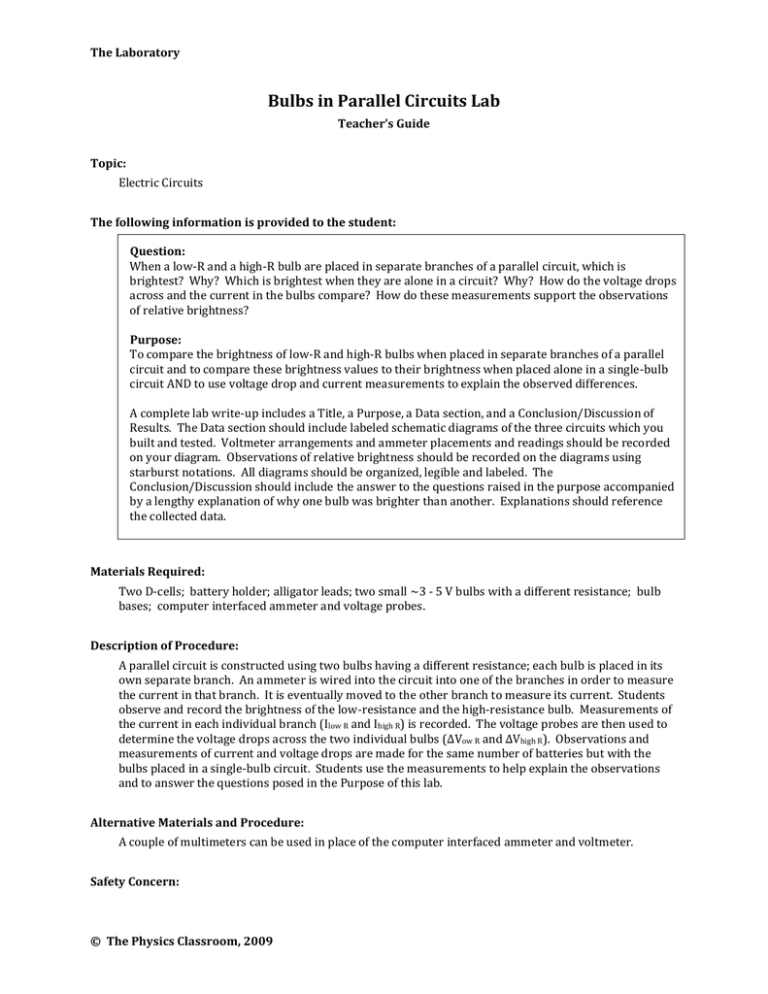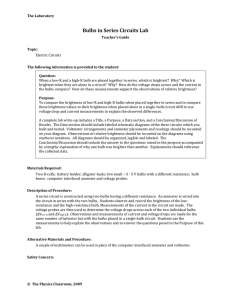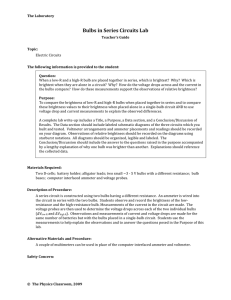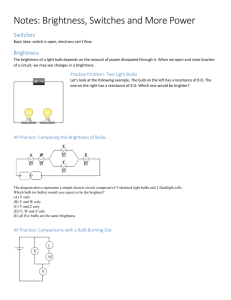Bulbs in Parallel Circuits Lab
advertisement

The Laboratory Bulbs in Parallel Circuits Lab Teacher’s Guide Topic: Electric Circuits The following information is provided to the student: Question: When a low-R and a high-R bulb are placed in separate branches of a parallel circuit, which is brightest? Why? Which is brightest when they are alone in a circuit? Why? How do the voltage drops across and the current in the bulbs compare? How do these measurements support the observations of relative brightness? Purpose: To compare the brightness of low-R and high-R bulbs when placed in separate branches of a parallel circuit and to compare these brightness values to their brightness when placed alone in a single-bulb circuit AND to use voltage drop and current measurements to explain the observed differences. A complete lab write-up includes a Title, a Purpose, a Data section, and a Conclusion/Discussion of Results. The Data section should include labeled schematic diagrams of the three circuits which you built and tested. Voltmeter arrangements and ammeter placements and readings should be recorded on your diagram. Observations of relative brightness should be recorded on the diagrams using starburst notations. All diagrams should be organized, legible and labeled. The Conclusion/Discussion should include the answer to the questions raised in the purpose accompanied by a lengthy explanation of why one bulb was brighter than another. Explanations should reference the collected data. Materials Required: Two D-cells; battery holder; alligator leads; two small ~3 - 5 V bulbs with a different resistance; bulb bases; computer interfaced ammeter and voltage probes. Description of Procedure: A parallel circuit is constructed using two bulbs having a different resistance; each bulb is placed in its own separate branch. An ammeter is wired into the circuit into one of the branches in order to measure the current in that branch. It is eventually moved to the other branch to measure its current. Students observe and record the brightness of the low-resistance and the high-resistance bulb. Measurements of the current in each individual branch (Ilow R and Ihigh R) is recorded. The voltage probes are then used to determine the voltage drops across the two individual bulbs (∆Vow R and ∆Vhigh R). Observations and measurements of current and voltage drops are made for the same number of batteries but with the bulbs placed in a single-bulb circuit. Students use the measurements to help explain the observations and to answer the questions posed in the Purpose of this lab. Alternative Materials and Procedure: A couple of multimeters can be used in place of the computer interfaced ammeter and voltmeter. Safety Concern: © The Physics Classroom, 2009 The Laboratory There is always a higher than usual level of risk associated with working in a science lab. Teachers should be aware of this and take the necessary precautions to insure that the working environment is as safe as possible. Student horseplay and off-task behaviors should not be tolerated. Suggestions, Precautions, Notes: 1. 2. Use the same bulbs used in the Round vs. Oblong – the Greatest Resistance? Lab. Students should have a record in their lab notebook about which of the two bulbs have the greatest resistance. They can refer to this record in order to complete this lab. If neither computer interfaced probes nor multimeters are available, then there is great merit in making the observations and altering the Purpose in such a manner that the measurement emphasis is removed. Auxiliary Materials: None Scoring Rubric: C10. Bulbs in Parallel Circuits Lab Included, labeled and organized all parts of the lab report. Data section includes schematic diagrams of the two-bulb parallel circuit, and the two single-bulb circuits; bulbs are labeled; ammeter locations and voltmeter arrangements are indicated. Relative brightness is indicated using starburst notation. Measured values are listed on the diagram and labeled as ∆Vlow R, ∆Vhigh R, Ilow R, etc. ; all necessary measurements are made; units are given. Diagrams are legible, labeled and organized. Conclusion/Discussion answers all the questions posed in the Purpose (and the Questions section). All comparisons are made. Measured data is used to explain the findings. Discussion is complete and accurate; reveals understanding. Connections to The Physics Classroom Tutorial: The following reading is a suitable accompaniment to this lab: http://www.physicsclassroom.com/Class/circuits/u9l4d.cfm Connections to Minds on Physics Internet Modules: Sublevels 8 and 10 of the Electric Circuits module are suitable accompaniments to this lab: http://www.physicsclassroom.com/mop/module.cfm © The Physics Classroom, 2009 Score _____/_____









